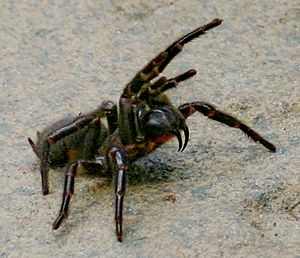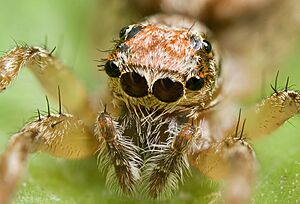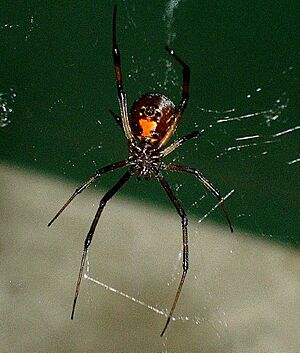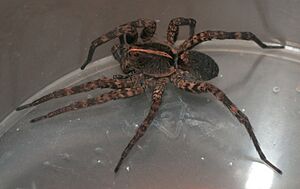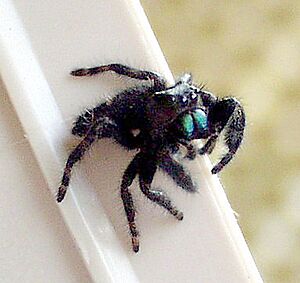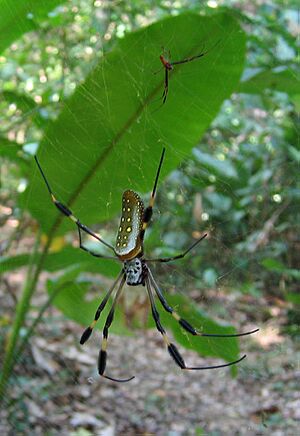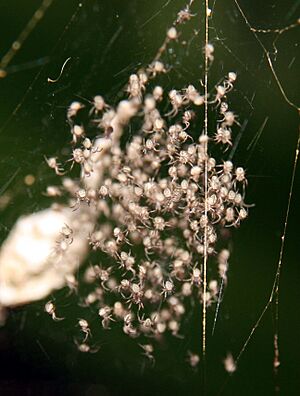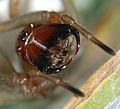Spider facts for kids
Quick facts for kids SpiderTemporal range: 319 mya
Upper Carboniferous to Recent |
|
|---|---|
 |
|
| Orb weaver spider (family: Araneidae) | |
| Scientific classification | |
| Kingdom: | |
| Phylum: | |
| Subphylum: | |
| Class: | |
| Order: |
Araneae
Clerck, 1757
|
| Suborders | |
|
Mesothelae |
|
Spiders are amazing creatures with eight legs. They are a type of arthropod, which means they have an outer skeleton. Spiders have special mouthparts called chelicerae with fangs. These fangs can inject venom into their prey. Most spiders also make silk, which they use for many things.
Spiders belong to the arachnid group, which also includes scorpions and ticks. There are about 40,000 different kinds, or species, of spiders known around the world. Scientists are always finding new ones!
Almost all spiders are predators. This means they hunt and eat other animals, mostly insects. Spiders have many clever ways to catch their food. Some build sticky spider webs to trap insects. Others throw a silk thread like a lasso. Some spiders hide in holes in the ground and jump out to grab passing insects. There are even spiders that make web 'nets' to throw over their prey. Some spiders are great jumpers and sneak up on insects before leaping on them.
Contents
Spider Body Parts
Spiders have two main body parts. The front part is called the cephalothorax. It's like their head and chest joined together. The back part is called the abdomen. Unlike insects, spiders do not have antennae.
Spiders have a special way of moving their legs. They don't have muscles that push their legs straight. Instead, they use hydraulic pressure, like a tiny water pump, to extend their limbs.
How Big Are Spiders?
Spiders come in many sizes. The smallest adult spiders can be less than 4 millimeters (about 0.1 inches) long. The largest spiders can have a body length of 10 centimeters (4 inches) or more. These big spiders can weigh up to 150 grams (5.3 ounces).
The biggest spiders are the tarantulas and the huntsman spiders. Some huntsman spiders in Southeast Asia can have a leg span of 250–300 millimeters (about 10–12 inches). That's as wide as a dinner plate!
Spider Eyes and Senses
Most spiders have four pairs of eyes, so eight eyes in total! These eyes are usually on the front-top part of their body. The way their eyes are arranged can be different for each spider family.
The main eyes at the front can form images, just like our eyes. Jumping spiders have amazing eyesight. Their vision is ten times better than dragonflies, which have the best vision among insects. A jumping spider's vision is only about five times less sharp than a human's! They can do this because they have special lenses and a four-layer retina. They can even move their eyes to scan an area.
Spiders also have other ways to sense the world. Their bodies are covered in tiny sensors, mostly bristles. These bristles can feel everything from a gentle touch to a weak breeze. They also have chemical sensors, which are like their sense of taste and smell. Spiders can also feel vibrations in their legs. For spiders that build webs, these touch and chemical sensors are more important than their eyes. Spiders that actively hunt, like jumping spiders, rely more on their eyes.
Spider Fangs
Spiders have very sharp fangs. These fangs are hollow, similar to a needle used for injections. Spiders use their fangs to inject toxins into the insects they catch. These toxins help to kill their prey. Some spider venoms affect the nervous system, while others break down body tissues.
Spider Behavior
What Most Spiders Eat
Almost all spiders are predators. They mostly eat insects and other small arthropods, including other spiders! Most spiders use their venom to kill their prey. Spiders usually don't try to catch prey much larger or much smaller than themselves.
Most spiders prefer to live alone because they might try to eat each other. However, some spiders do live in groups. While early spiders lived before birds and mammals, some modern spiders can eat small fish, small birds, and even tiny mammals.
The black widow spider got its name because the female sometimes eats the male after they mate. This can happen with other spider species too. Each spider species has its own way of communicating. To avoid being eaten, some male spiders have special hooks on their front legs to hold the female during mating. Others bring the female a gift of food. In some species, the male is so much smaller than the female that she wouldn't bother trying to eat him.
Most spiders have poor vision and won't even notice a dead insect. But Jumping spiders are different. They have such good eyesight that they can find recently dead flies or other insects to eat.
Some Spiders Are Not Predators
While most spiders are predators, there are exceptions. The jumping spider Bagheera kiplingi gets over 90% of its food from plant material. It eats special parts of acacia plants.
Young spiders of several families also drink plant nectar. They do this for long periods and clean themselves while feeding. They prefer sugar solutions over plain water, showing they are looking for nutrients. Many spiders are nocturnal, meaning they are active at night. Nectar contains more than just sugar; it has amino acids, lipids, vitamins, and minerals. Studies show that spiders live longer when nectar is available. Eating nectar also avoids the dangers of fighting prey and the energy needed to make venom.
Some spiders also eat dead arthropods (scavenging), web silk, and their own shed exoskeletons. Pollen caught in webs can also be eaten. Studies show that young spiders have a better chance of survival if they eat pollen. In captivity, some spiders have even been known to eat bananas, marmalade, milk, egg yolk, and sausages.
How Spiders Catch Prey
Webs
The most famous way spiders catch food is with a sticky web. Spiders build different kinds of webs to catch different insects. Flat, horizontal webs can trap insects flying up from plants below. Flat vertical webs catch insects flying through the air. Spiders that build webs usually don't see very well, but they are very good at feeling vibrations.
Underwater Spiders
The female water spider Argyroneta aquatica builds underwater "diving bell" webs. She fills these with air and uses them for eating, molting, mating, and raising her babies. She lives almost entirely inside the bell, darting out to catch prey that touches the bell or its anchor threads. A few spiders use the surface of lakes and ponds like "webs," sensing trapped insects by their struggles.
Bola Casting
Net-casting spiders weave small webs and then use them like a net. They stretch their webs and release them when prey hits. Spiders in the family Deinopidae weave even smaller webs. They hold these webs stretched between their front two pairs of legs. Then, they lunge forward, pushing the web up to twice their body length to trap prey. This move can make the web's area ten times bigger!
Bolas spiders, like those in the genus Mastophora, build a "web" that is just a single "trapeze line." They also make a bolas, which is a single thread with a sticky ball of silk at the end. They release chemicals that smell like pheromones from moths, then swing the bolas to catch the moths. They catch about the same amount of insects as web-weaving spiders of similar size. If they don't catch anything in about 30 minutes, they eat the bolas, rest, and make a new one. Younger bolas spiders and males are much smaller and don't make bolas. Instead, they release different pheromones to attract moth flies and catch them with their front legs.
Using Trapdoors
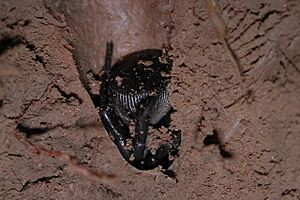
Some spiders, like the primitive Liphistiidae, "trapdoor spiders" (family Ctenizidae), and many tarantulas, are ambush predators. They hide in burrows, often with trapdoors. They might also have silk threads around the entrance that tell them when prey is near. Other ambush predators, like many crab spiders, don't use these aids. Some spiders that hunt bees can even change their color to match the flowers where they hide. Wolf spiders, jumping spiders, fishing spiders, and some crab spiders chase their prey. They mostly use their vision to find food.
Catching Insects Without Webs
Not all spiders use silk webs to catch their food. Instead, these spiders grab insects and bite them. The two most well-known types of these spiders are wolf spiders and jumping spiders.
Wolf Spiders
A Wolf spider usually waits for an insect to come close. Then, it rushes at the insect, grabs it with its front legs, and bites it. Its venom then does its job.
Female wolf spiders lay their eggs on a silk pad. They then pull the edges together to make a round ball. They carry this egg ball with them everywhere they go, holding it to their tail end with silk. When the eggs hatch, the tiny spiderlings crawl onto their mother's back. She carries them for days or weeks.
Wolf spiders are very good mothers. They strongly protect both their egg balls and their babies. When the time is right, the little spiders leave their mother and go off on their own.
Jumping Spiders
Jumping spiders have excellent eyes and can see very well. They sneak as close to an insect as they can. Then, they jump onto the insect and immediately bite it. Since they often hunt in trees, bushes, and on walls, they might fall if they miss. But they have a clever way to stay safe! Before they jump, they attach their silk to where they are standing. As they jump, they let out a silk safety line. So, if they fall, they will catch themselves when they reach the end of their silk line. Sometimes, a jumping spider will catch an insect and then fall while still holding it. But the spider is still safe.
Jumping spiders make small silk "tents" to sleep in. When they lay eggs, they keep them inside these shelters. They do not carry their eggs with them when they go hunting.
For all male spiders, finding a mate can be dangerous. The female spider might not realize the male is her kind and try to eat him. Jumping spiders have special visual patterns that help them recognize each other. Male jumping spiders also do a special dance when they approach a female of the same species. This way, the female knows he is a male of her kind. She will usually forget about eating long enough to mate with him.
Jumping spiders have such good eyes that they will often watch any human who tries to watch them. Some species are shy and will run away if a human gets too close. But some species, like Phidippus audax (the brave jumping spider) and Platycryptus undatus, can become calm if a human approaches them slowly. Sometimes, they will jump onto a finger and then jump from finger to finger, exploring.
Hunting Other Spiders
Some jumping spiders in the genus Portia hunt other spiders in ways that seem very smart. They might sneak around their victims or trick them out of their webs. Studies show that Portia's natural hunting methods are just a starting point. These spiders learn very quickly how to catch new types of prey through trial and error. However, they seem to be slower thinkers, which makes sense because their brains are much smaller than those of mammal predators.
Disguising as Ants
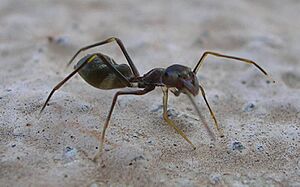
Ant-mimicking spiders face several challenges to look like ants. They often have thinner abdomens and fake "waists" to copy an ant's three body parts. They wave their first pair of legs like antennae, which spiders don't have, to hide their eight legs. They have large colored patches around some eyes to hide their eight simple eyes, as ants have two compound eyes. They also cover their bodies with shiny hairs to look like ants. In some spider species, males and females copy different ant species because female spiders are usually much larger than males.
Ant-mimicking spiders also change how they move to act like the ants they are copying. For example, many walk in a zig-zag pattern. Ant-mimicking jumping spiders avoid jumping. Spiders of the genus Synemosyna walk on the outer edges of leaves, just like Pseudomyrmex ants. Spiders and other arthropods might mimic ants to protect themselves from predators that hunt by sight, like birds, lizards, and other spiders. However, some ant-mimicking spiders actually hunt ants or the ants' "livestock" like aphids. When resting, the ant-mimicking crab spider Amyciaea doesn't look much like Oecophylla ants. But when hunting, it acts like a dying ant to attract worker ants. After catching prey, some ant-mimicking spiders hold their victims between themselves and large groups of ants to avoid being attacked.
Reproduction and Life Cycle
Spiders reproduce sexually. Male spiders make small silk webs where they put their sperm. Then, they transfer the sperm to special parts on the tips of their pedipalps (small leg-like feelers near their mouth). When a male spider senses a female nearby, he checks if she is the same species and ready to mate. For example, in web-building spiders, the male can tell the species and sex of the female by the smell of her web or 'safety ropes'.
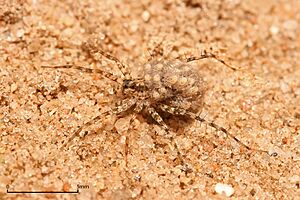
Spiders often have special courtship rituals. These rituals help prevent the large females from eating the small males before mating. This is especially true unless the male is so tiny that he's not worth eating. For web-weaving spiders, specific vibrations in the web are a big part of these rituals. For spiders that hunt actively, touching the female's body in certain ways is important and can even "hypnotize" her. For jumping spiders, which have great eyesight, the male's gestures and dances are very important. If the courtship works, the male injects his sperm into the female.
Males do get eaten in some species. In Australia, over 60% of female redback spiders kill and eat the male after mating. In some species, males mate with females that have just shed their skin. At this time, the females are too weak to be dangerous to the males. However, males of most species survive a few matings. Their short lives are usually the main limit. Some males even live for a while in their mates' webs.
Female spiders lay up to 3,000 eggs in one or more silk egg sacs. These sacs keep the eggs at a good humidity level. In some species, the females die after laying eggs. But females of other species protect the sacs. They might attach them to their webs, hide them in nests, carry them in their chelicerae, or attach them to their spinnerets and drag them along.
Development of Young Spiders
Baby spiders go through all their larval stages inside the egg. They hatch as spiderlings, which are very small and not fully grown, but they look like tiny adults. Some spiders care for their young. For example, a wolf spider's babies cling to rough bristles on their mother's back. Females of some species respond to their young's "begging" behavior by giving them prey (if it's no longer struggling) or even regurgitating food for them.
Like other arthropods, spiders must molt (shed their outer skin) to grow. Their outer skin, called a cuticle, cannot stretch. Most spiders live for only one to two years. However, some tarantulas can live for over 20 years in captivity!
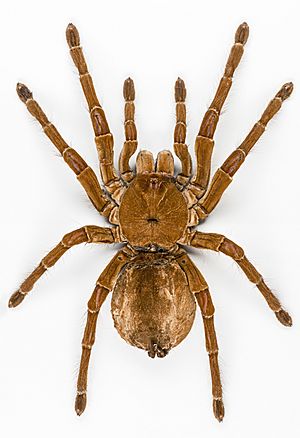
Spiders and Humans
Out of the 40,000 known spider species, fewer than 12 are known to be truly dangerous to humans. Most spider bites are painful but not life-threatening. Most spiders use venom to paralyze their prey, then kill it by eating or biting. A few spiders have venoms that can be dangerous to people who are weak or allergic to them. Since 1927, 13 people have died after being bitten by a Atrax robustus spider from Australia.
The spider that causes the most deaths, the black widow and other spiders in its genus Latrodextus, are about 1 centimeter (0.4 inches) long. The Atrax and Phoneutria spiders, which can also be deadly, average about 2.5 centimeters (1 inch). Even the Widow spiders are large enough to be easily noticed.
Even relatively small spiders like Phidippus audax can give a painful bite if you hurt them. But spiders are very helpful to humans because they control insects that eat our crops.
Being afraid of spiders is a very common phobia (fear). Widow spiders (black widows and other members of their genus) never willingly leave their webs. So, people usually get bitten when they accidentally touch the spider.
Images for kids
-
A jumping spider seen in Chennai.
-
The Phonognatha graeffei or leaf-curling spider's web serves both as a trap and as a way of making its home in a leaf.
-
Spider preserved in amber
-
Leucauge venusta, an orb-web spider
-
Cooked tarantulas are considered a delicacy in Cambodia.
See also
 In Spanish: Arañas para niños
In Spanish: Arañas para niños


